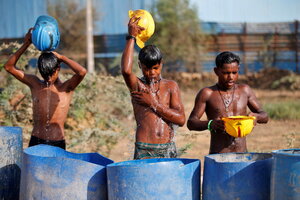A heat wave forges cool ideas
Scorcher weather in South Asia, combined with predictions on climate change, help accelerate energy innovation.

Workers use their helmets to pour water to cool themselves off near a construction site on a hot summer day on the outskirts of Ahmedabad, India, April 30.
Reuters
There are two ways to measure the heat wave that has settled over South Asia in recent weeks. One is by the mercury. Temperatures were 8 to 15 degrees Fahrenheit above normal across India in April, following the hottest March on record. New Delhi has reached 114 degrees. In Pakistan’s Balochistan province, thermometers have topped 120 degrees.
The extreme weather has ignited urban garbage dumps, shuttered schools, and scorched crops. It also fits projections by the United Nations panel of climate scientists that regions like South Asia and the Horn of Africa face increasingly dire conditions in this century.
The other way to measure the heat wave is by the abundance of ideas emerging to deal with it. India and Pakistan are becoming hubs for new thinking about urban design, agricultural practices, and public policy in the world’s hottest regions. Private innovators from five regional countries – India, Pakistan, Bangladesh, Sri Lanka, and Bhutan – are partnering with the European Institute of Innovation and Technology to promote climate entrepreneurship.
“We are doing some things right, but it’s time to up our game – because we have to live with the heat,” Chandni Singh, senior researcher at the Indian Institute for Human Settlements, told the BBC. “There is so much innovation internationally that we can learn from.”
South Asia’s response to the heat wave reflects two trends in the global debate about climate change.
One is that the threat is driving an era of innovation. The World Bank estimates that the world needs $90 trillion in green investments by 2030. Those funds, it concluded, could potentially generate four times their value in additional economic activity.
The other is that the private sector is stepping up to help achieve the goal of net-zero greenhouse gas emissions. As the Boston Consulting Group noted in a March report, that provides an opportunity for governments and investors to think differently by “looking at companies as providers of solutions rather than only sources of emissions, focusing on new sources of revenue over rising costs, and seeking transformative models rather than incremental improvements.”
In India, that thinking is reflected in strategies the government is developing with local officials, civil society organizations, and international groups to adapt to severe heat events in 23 states and 130 cities. The plans are modeled after an early warning system adopted by the city of Ahmedabad that has successfully reduced annual heat-induced fatalities since 2013. They also include a range of heat-reducing strategies gaining favor globally, like better-ventilated building designs, heat-reflecting roofs, and new materials for cooler roads.
India’s neighbors are developing similar approaches. A study published in the journal Atmosphere this week showed that rising temperatures are compelling the region’s governments to find the right mix of ideas: technology sharing, urban green spaces, changes in architecture and infrastructure, labor reforms, early warning systems, water-saving community-based agriculture, and investment in innovation.
From Pakistan to Sri Lanka, the study found, adapting to changing weather patterns requires enabling communities to adopt an ever-widening range of tools to keep their cities livable. That starts with seeing beyond the predicament of climate change to the potential for adopting new ideas.

